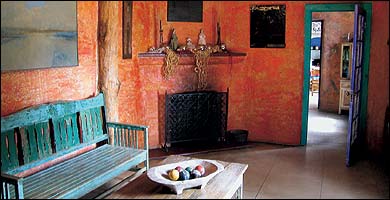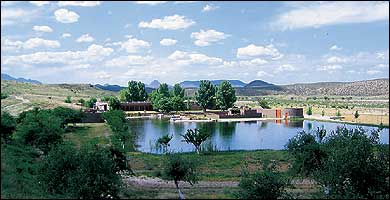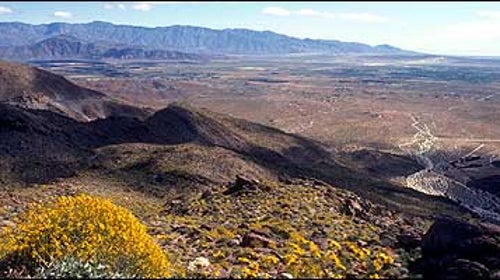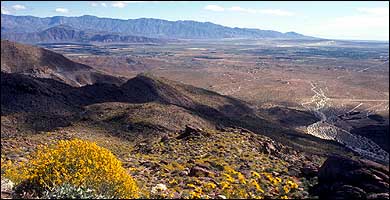The last time I visited Anza-Borrego—a forbidding wilderness extending from the Salton Sea west to the Laguna Mountains and from the Mexican border north to Riverside County—a friend and I mountain-biked up to the Carrizo Badlands Overlook for views of a 100,000-acre expanse of alkali desert and small ranges, where sunsets turn the jagged little mountains flame-red. Another favorite jaunt of mine is hiking two days through Coyote Canyon, with its riparian woodlands of willow, California fan palms, mesquite, and acacia, and spring-fed Coyote Creek.
SLEEP: Borrego Valley Inn has the two essential ingredients of a desert hideaway: seclusion and privacy. The 15-room inn, with two pools, is on ten acres in the town of Borrego Springs. The saltillo-tiled, earth-toned rooms all have private patios and are situated around a large courtyard with a garden and a finch-filled aviary. (Doubles, $120–$220 per night, breakfast included; 800-333-5810, )
PLAY: Get hiking maps at Anza-Borrego’s visitor center, a half-mile from the inn. Smoketree Arabian Ranch (760-767-5850, ), across the street from the inn, leads horseback day tours to the park ($200 per person).
EAT: Badlands Café and Market (760-767-4058), in Borrego Springs, makes great picnic lunches. Catch a grizzled desert rat crooning “Summer Wind” on karaoke night at Carlee’s Place (760-767-3262).
Arizona: Saguaro National Park

This two-part park to the east and west of Tucson is made for winter hiking. Head to the 66,621-acre Rincon Mountain District, in Saguaro National Park’s eastern section—15 miles east of the city—for more than 120 miles of trails threading pines, at higher elevations, and saguaros, on the desert floor.
The graceful saguaro is one of the world’s largest and slowest-growing cactuses, reaching up to 50 feet over the course of two centuries. Hiking among them is the quintessential desert experience—especially at dusk, when the giants are silhouetted against purple twilight.
SLEEP: Rancho de la Osa Guest Ranch, an elegant cross between a spa and a dude ranch, is set on 600 acres just north of the Mexican border near Sasabe, an hour southwest of the park. The 19 guest rooms, laid out in single-story adobe wings, are decorated with Mexican antiques. Take one of the ranch’s 50 horses on a trail ride, then visit the new fitness center and spa for treatments like Swedish or hot-stone massage. (Doubles, $360–$450, including meals and riding; 800-872-6240, )
PLAY: Sky Island Treks (520-622-6966, ) leads day hikes, or if you’re on your own, stop at the park’s visitor center.
EAT: The dinner show at Saguaro Corners (520-886-5424, ), a steakhouse across from the park entrance: javelinas, coyotes, or deer—seen through floor-to-ceiling windows—munching their supper as you eat yours.
New Mexico: White Sands National Monument

When perched atop a dune at White Sands National Monument, your first impression is that you’re standing in the world’s biggest sandbox. Your second impression—if you’re like me—is that you must run, roll, and dive among the dunes until you fall down, exhausted and sand-encrusted.
White gypsum sand, constantly rearranged by strong westerly winds, covers nearly 275 square miles. The best hike is the 4.6-mile trail to Alkali Flat. Camp anywhere off the trail, but leave some bread crumbs: It’s frighteningly easy to get lost.
SLEEP: Sierra Grande Lodge and Spa is in downtown Truth or Consequences—the only U.S. town named after a game show—a one-and-a-half-hour drive northwest of White Sands. Serge Raoul (famous for his SoHo bistro, Raoul’s) and his brother spent three years restoring the place. The 16 rooms have hardwood floors and handcrafted furniture, and an open-air tub pipes water in from the town’s hot springs. The spa menu includes salt scrubs and massages, which run $60 to $100. (Doubles, $95–$125; 505-894-6976, )
PLAY: Buy a plastic saucer ($9.75) at White Sands Concessions, behind the visitor center, and sled the dunes like a grammar-schooler on a snow day.
EAT: Sierra Grande’s restaurant features many of the signature dishes from Raoul’s, in New York, including steak au poivre.
Texas: Big Bend National Park

The most popular Big Bend attraction is floating the Rio Grande through some of the country’s most remote canyons, in the immense Chihuahuan Desert. Santa Elena Canyon, with its 1,500-foot limestone cliffs and Class III–IV rapids, is the most impressive and most frequently rafted, but some of the more isolated lower canyons are well worth seven- to ten-day trips.
SLEEP: Cibolo Creek Ranch began as three forts that cattleman Milton Faver built in 1857 to guard against Apache and Comanche attacks. Lodging is divided up among the forts, spread out on 32,000 acres: 22 rooms at El Cibolo, ten rooms at La Cienega, and a romantic cottage at La Morita. The guest rooms replicate 1880s style, with saltillo floors, cottonwood beams, and Mexican antiques. You’ll enjoy the overwhelming fantasy—especially when guides take you on a cattle drive—that you’re a very wealthy Texas rancher. (Doubles, $450, including meals; 432-229-3737, ) PLAY: Rio Grande ���ϳԹ���s (800-343-1640, ) and Big Bend River Tours (800-545-4240, ) offer rafting trips in the park from about $125 per person for one day to $1,400–$1,500 for ten days.
EAT: Drive 90 minutes north from the park to Marfa, a burgeoning art community and West Texas cow town, for a margarita at Hotel Paisano’s 1930s-era bar (432-729-3669, ).


